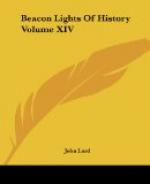of the earth that covered the palace of Shalmaneser
at Nimroud, had not the Frenchman Botta disclosed the
friezes and sphinxes of Sargon at Khorsabad; and in
these late years is it not the Frenchman De Sarzec
who has brought from Telloh to the Louvre the statues
of Chaldean kings that lived almost five thousand years
ago? And so to France was given the right, for
the honor and enrichment of the Louvre, to explore
Persia; and De Morgan went to Susa, to Shushan, the
palace of Xerxes and Darius, of Ahasuerus and Esther,
in search of what was far earlier than they, for another
Frenchman and his wife, M. and
Mme. Dieulafoy,
had already excavated the noble palace of these Persian
kings. Far below the palace of Xerxes he has found
vastly earlier remains. There is the column set
up, if we can believe the Assyriologists who trust
the chronology of Nabonidus, the last king of Babylon,—and
it is not incredible,—three thousand eight
hundred years before Christ, by Naram-Sin, a Babylonian
king, to commemorate one of his raids into the land
of what were perhaps his stronger enemies. It
is a noble composition, with archaic writing, and a
stately figure of the king climbing the mountains
and slaying his enemies; it shows an art that might
well have developed into the best that Greece has produced.
But De Morgan has only begun to scratch the surface
of the mounds of Elam, and a multitude of scholars
believe that out of Elam came the first civilization
of Chaldea. We shall find out yet; for the record
is in the earth, and only waits the man who will dig
it out, and then the man who will read it.
We are tempted to go further east and recall that
in India, the land where Alexander made his most distant
conquests, a multitude of English scholars have been
searching the ruins of old temples for the earliest
memorials of the worship of Buddha. Just now they
have found his birthplace and precious relics.
But that takes us too far afield, and would tempt
us to further excursions in Burmah and China.
We must come back to Western Asia and the shores of
Europe.
As has been indicated, the greatest puzzle of ancient
history is that of the Hittite empire, which seems
to have ruled all Asia Minor at some uncertain time,
and to have extended over Syria and Palestine.
No sooner had the greatest Egyptian kings, Thothmes
and Rameses, ventured their armies into Asia, perhaps
in vengeance on the incursions of Ionian pirates,
perhaps in requital of the tyrannies of the hated Shepherd
Kings, than they learned of the Hittites on the shores
of the Euphrates. Then, a century or two later,
a mass of official correspondence sent by the Kings
of Palestine and Syria, dug up in Egypt, reports that
the Hittites had appeared as invaders from the north
and beseeches military aid. But the power of
Egypt had waned, and the Hittites were supreme until
the Assyrians began and carried on for five centuries
the uncertain war which ended in the utter overthrow




